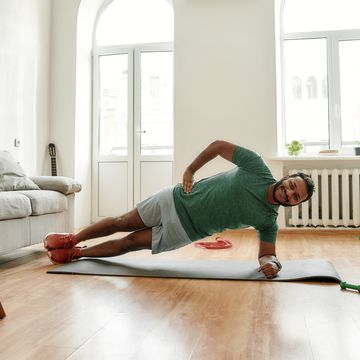Resistance bands are simply one of the best value pieces of kit a runner can have. They are usually very cheap to buy, versatile, easy to use in a variety of ways and barely take up any space - specially compared to home weights or gym equipment. Indeed if you are looking to cut costs by cancelling gym memberships, they really are the best value home kit you can get. Plus, if you travel a lot for work or leisure, they are easy to pop in a bag for work outs away from home.
If you don't already own a set, then why not spend a few pounds on them now and use our ultimate guide to the best resistance band exercises, specially for runners. We've even got a guide to the best you can buy, so that is a good place to start How to choose between morning and evening runs.
Then, once you have your equipment to hand, you need to know how to use it effectively, particularly to boost your running strength, speed and endurance, while also helping you avoid injury.
'I get my clients to use bands all the time,' says running coach Nick Anderson (runningwithus.com). 'They can come back from their runs and pack in strength and conditioning work without going to a gym.'
Anderson recommends starting with a thin band (thinner bands offer less resistance so are 'easier' to work with) and then building up from there – you can always increase the resistance by making that same band shorter or by doubling it up. 'It's tempting to let the band's recoil pull you back quickly, but that would nullify half your workout,' Anderson says. 'So keep it steady.'
Resistance bands let you isolate and work on particular muscle groups and provide many of the benefits of lifting weights with less of the hassle. They do this by putting constant tension on your body, which is why you shouldn't let that tension slack and let the band pull you back in too quickly.
For runners who often neglect their upper body and core, this means you can balance out your runs with a full-body workout.
Do these exercises regularly, at least once a week, and you will strengthen your ankles, glutes and hips in particular, which in turn will result in fewer injuries or IT band problems.
Resistance band exercises for legs
Sidesteps
Loop the band either above your knees (least resistance), below your knees (medium resistance) or around your ankles (greatest resistance). Bend your knees slightly with your feet hip-width apart.
Step to the side until the band offers a reasonable amount of resistance, then slide your standing foot towards your other foot so that you move sideways. Repeat this sidestepping movement for 3-6 metres in one direction, then go in the other direction. Slowly build up the distance you move in each direction.
Monster walk
Loop the band around your legs, either above the knee (less resistance) or below the knee for more resistance. Legs should be hip-width apart and bent at the knee. Step forward and to the side at a 45-degree angle, ensuring your knees remain bent. Repeat with the other leg. Walk forwards 3-6 metres at first then slowly increase the distance.
Ankle dorsiflexion
Sit on the floor with one leg extended in front of you, the other bent at the knee. Loop the resistance band around your foot and attach the other end to an anchor/something secure. Pull your foot back towards your shin. When you reach maximum dorsiflexion, return your foot to its original position. Continue until failure, then change feet.
Hip adduction
Tie a resistance band to an anchor at ankle level. Loop the band around your anchor-side leg, just above ankle level, with your other foot positioned slightly back. Hold onto something secure for balance. Keeping your knee straight, pull your leg in, across the other leg. Slowly return to the starting position. Continue until fatigued, then swap positions to work the other leg.
Ankle inversion
Sit in a chair with one end of the resistance band secured to an anchor at ankle level. Loop the other end around your forefoot. With your knee straight, pull your foot inward, turning on the heel at the ankle. When you reach the maximum range of motion, slowly return to the starting position. Continue to failure, then swap feet.
Leg raises
Wobble board exercises for foot and core strength resistance band around your ankles. Lift your right leg about 45 degrees in a controlled manner, then lower. Do 30 reps, then switch sides and repeat.
Clamshells
Lie on your left side with your knees together and a resistance band around your lower thighs. Your knees should be bent at 90 degrees, with your thighs at a 45-degree angle from your body. Keeping your pelvis still and your feet together, raise your right knee in a controlled manner. Do 30 reps, then switch sides.
Banded squats
Place the band just above your knees and stand with feet shoulder-width apart. Slowly lower into a squat. Inhale as you go and push your knees out against the band's resistance.
Exhale as you drive back up through your heels, squeezing your glutes. Use your glutes to push your hips slightly forward at the top.
Incline glute bridge
Lie down, band around your knees, feet on a chair. Tilt your pelvis towards your belly button and squeeze your glutes.
Raise your hips while opening your knees as wide as you can against the band, and exhale. Hold for two secs, squeezing your bum and pushing against the band, then lower slowly. Let your bum touch the ground before repeating the move.
Banded hip thruster
Sit back with your shoulder blades resting on a chair or bench and place the band around your knees. Tilt your pelvis towards your belly button and squeeze your glutes.
Raise your hips while opening your knees as wide as you can against the band, and exhale. At the top, hold for two seconds, pushing against the band. Lower down slowly, lightly touching your bum to the ground and repeat.
Sit to stand
Sit in a chair with both feet on top of the band, each hand holding one end of it. Extend your left leg. Use your right leg to stand up. You’ll need to bend slightly forward. Lower back down to the chair using your right leg. Repeat on the other leg.
How can I get rid of a side stitch during running
Core twist and variations
For this exercise, you will need a longer resistance band with handles. Attach it to an anchor at shoulder level. Stand with your arms extended out in front of you, at right angles to the band. Keeping your arms straight, rotate your body away from the band by 90 degrees. Hold for two seconds, then slowly release back to the start position. Do six sets on both sides.
Re-anchor the band at a low level (about knee height). Rotate, bringing the band up diagonally so that you finish with it above your shoulders. Do six sets on both sides.
Re-anchor the band above head height. Rotate your body and bring the band diagonally downwards, again repeating six sets on both sides.
Overhead tricep extension
Using two longer bands attached together, stand on the lower band with your right foot and pull the upper band up behind your head so your elbows are bent at 90 degrees. Your elbows should be near your ears.
Maintaining tension on the band, press your arms overhead by extending at the elbows only. Return to the starting position and repeat.
Overhead press and squat
Attach two longer bands together, then stand on the bottom band with both feet. Holding the top band, press your arms up and out to a 45-degree angle so your body looks like a 'Y'.
Maintaining tension on the bands, bend your knees and squat until your thighs are at least parallel with the floor – go lower if you can. Return to standing, then lower your arms to your shoulders. Repeat.
Arm swing
Loop a long band with handles around a sturdy object. Hold both ends of the band. Alternate bending and straightening your elbows to pump your arms as if you were running. If you find this move too easy, stand on one leg as you pump your arms, which will work your core muscles as well.















